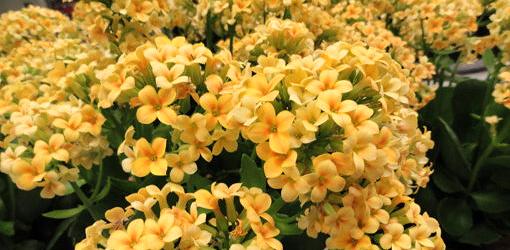Flowering kalanchoes are staples of the holiday and florist trade, with their cheery clusters of blooms on compact, upright plants sure to brighten your windowsill. Like poinsettias and holiday cactus, kalanchoes bloom in response to the length of daylight, so they can be encouraged to bloom even during the darkest days of winter.
If you received a flowering kalanchoe as a gift this year, or if you couldn’t resist the bright midwinter color, here are some tips for keeping your plant healthy and blooming for years to come.
About Kalanchoe
Everyone pronounces it differently (and nobody knows exactly who’s right), but we’ve all seen the colorful, happy flower clusters of Kalanchoe blossfeldana, or flowering Kalanchoe. A cousin to the Jade plant, flowering Kalanchoe is a fairly low-maintenance succulent house plant.
 Flower heads on kalanchoe blossom in bright oranges, pinks, yellow, red, and white on a compact, upright plant about 6-12 inches tall. The flowers last several months, and the green plants are pretty year-round.
Flower heads on kalanchoe blossom in bright oranges, pinks, yellow, red, and white on a compact, upright plant about 6-12 inches tall. The flowers last several months, and the green plants are pretty year-round.
K. blossfeldana is the most common variety of kalanchoe, but there are many varieties to choose from, including pendant (hanging) varieties and nonflowering varieties grown for their unique foliage. All kalanchoes have the same growing requirements.
Kalanchoe Growing Tips
Kalanchoes are pretty low-maintenance plants, thriving in the low humidity of winter households. Choose Kalanchoe plants that have plenty of unopened flower buds, rather than ones in full bloom, and be sure to give them:
- Light: Kalanches need lots of light, preferably a south-facing window in winter and bright indirect light (or east/west window) in summer. If your Kalanchoe plant is looking leggy and thin, it probably isn’t getting enough light.
- Soil: Kalanchoe plants do best in a well-draining potting mix designed for cacti and succulents, or stir in plenty of perlite or sand to improve drainage.
- Temperature: Kalanchoes do fine in normal household conditions, but they need to be kept away from drafts. Keep your kalanchoe above 50°F.
- Water: Over-watering is the main killer of kalanchoes! Allow your kalanchoe to get dry between waterings. Then water thoroughly until it runs out the bottom, and immediately empty the drainage tray. Never leave the plant sitting in water.
- Fertilizer: While your kalanchoe is blooming, feed it every few weeks with a balanced organic fertilizer.
- Pots: Kalanchoes do well in clay pots, and they must have a drainage tray that can be emptied. They’re small plants that don’t often have to be repotted.
- Summer care: You can put your kalanchoe outdoors in summer, but choose a spot sheltered from rain.
- Propagation: Kalanchoes are easy to propagate by stem or leaf cuttings. Some varieties will put out plantlets that can be removed and potted.
- Maintenance: Remove spent flowers to keep your kalanchoe looking neat. You may also want to wipe or gently spray them to remove dust.


How to Make Kalanchoe Bloom
Many people treat kalanchoes as an annual, throwing them away after they finish blooming. Getting them to bloom again requires some discipline, but the fun part is that once you get the hang of it, you can make your kalanchoes bloom on cue! Here are some tips for getting your kalanchoe to bloom again:
- Flowering Depends on Light: Kalanchoes are photoperiodic, which means they bloom in response to the length of day. They naturally bloom in early spring. To force your plant to set flower buds requires six weeks of simulated winter lighting conditions.
- Reduce Watering: Water half as often, or even less, during the six weeks.
- Simulate Night: For six weeks, put your plant in complete darkness for 14 hours a day, and in bright light for 10 hours a day. You can bring it in and out of a closet, or use a cover, to achieve full darkness. After six weeks or so, when you see flower buds forming, you can bring your plant back out into normal light conditions and resume watering. For more tips about photoperiodic blooming, check out our articles on how to grow poinsettias and holiday cactus.
Comments
Post a Comment